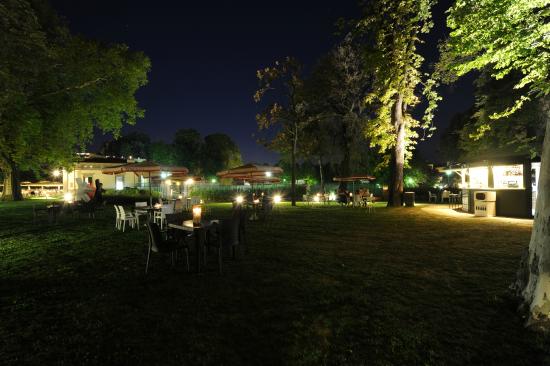Last Sunday I was invited to an evening dinner as guest of my elderly neighbour and local artist Giampiero Garzella. The venue was his favourite place to eat, drink and play the odd game of cards, Ristorante Antico Caffè delle Mura in Lucca. There were two reasons for the occasion, first to simply gather together some of his old friends for an enjoyable meal and secondly to discuss his art.
His friends, now all mostly retired Lucchese men included a nuclear physicist, an accountant, a lawyer, a journalist, a cousin well-known locally for his woodwork particularly carving in chestnut and five others, making the gathering twelve in number.
Giampiero’s art was proudly on display in a semi-permanent exhibition on the walls of the Antico Caffè. His style he says is minimalismo (minimalist) where he tries to express his thoughts, ideas and passions by using simple or primary forms or structures often using geometric shapes, planes and colour. Giampiero admits that for him it is not easy to convince his fellow Lucchese of the importance of this branch of modern art. Indeed after a short while the conversation turned to other subjects such as the problems of the economy, lack of opportunities especially for the youth in Lucca that look to big cities abroad, in particular London, to find employment and life experiences.
Giampiero works tirelessly at his art in his small one-room studio that is also his home. A couple of decades ago he worked in the south of France near Montecarlo, Nice and Cannes where he was able to sell his work with reasonable success. He was originally a tailor in Lucca like his father and grandfather before him. His grandfather owned a tailoring academy famous in Lucca and throughout Italy and beyond where one of his clients was the great opera composer Giacomo Puccini. His father made clothes for Picasso and was once sent a caricature of him drawn by the famous artist praising him for his work as a tailor. Giampiero still makes suits for himself and he looked very elegant in a beautifully made suit he had hand-stitched made out of English woollen cloth that he still considers the finest in the world.
His inspiration for much of his art comes from the late 19th and early 20th Century artists ranging from work such as Courbet’s Origin of the World to Braque, Picasso and Cezanne and also the work of the Tuscan artists known as the Macchiaoli which will feature in another journal entry this year.
It took Giampiero and me nearly two hours after dinner to stroll back 500 metres to Piazza Cittàdella. We tried to discuss weighty subjects such as art, Lucca and the even the ‘meaning of life’ on a full stomach consisting of five courses of fish and seafood, some fine local Vermentino and several lemoncellos.
I was surprised to see quite how distinguished those guests were round the dinner table. The meal made the newspaper La Nazione the next day


